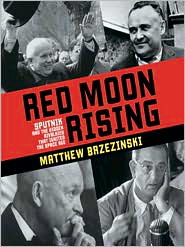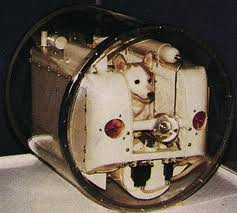“The missile that lofted Sputnik into space had…shattered America’s sense of invulnerability. For the first time geography had ceased to be a barrier, and the U.S. mainland lay exposed to enemy fire.”
Focusing o n the period between 1956 and 1958, Matthew Brzezinski recreates the Cold War atmosphere which began in the aftermath of World War II and culminated with the Russian launching of Sputnik in October, 1957. Both the United States and the Soviet Union, in their rush to occupy their post-war sectors of Germany, had wanted to acquire as much German technology as possible—rockets, missiles, and, of course, the German scientists who made it all possible. The US had all the advantages—finding a secret missile lab (hidden in a mountain with a concentration camp in front of it), removing dozens of advanced rockets and missiles to the US, and enticing key scientists to emigrate to the United States. Still, it was the Soviet Union, with far fewer spoils of war and much less developed missile programs, which succeeded in orbiting the first satellite.
n the period between 1956 and 1958, Matthew Brzezinski recreates the Cold War atmosphere which began in the aftermath of World War II and culminated with the Russian launching of Sputnik in October, 1957. Both the United States and the Soviet Union, in their rush to occupy their post-war sectors of Germany, had wanted to acquire as much German technology as possible—rockets, missiles, and, of course, the German scientists who made it all possible. The US had all the advantages—finding a secret missile lab (hidden in a mountain with a concentration camp in front of it), removing dozens of advanced rockets and missiles to the US, and enticing key scientists to emigrate to the United States. Still, it was the Soviet Union, with far fewer spoils of war and much less developed missile programs, which succeeded in orbiting the first satellite.

Brzezinski’s extensive research, detailed character analyses of the key players and their subordinates, and vivid recreations of the economic and political realities of both countries increase the tension in the lead-up to Sputnik. Sociological details about the U-2 development, the Little Rock demonstrations, the civil rights movement, and the political infighting in the Eisenhower administration are balanced by analyses of the USSR’s problems with rebellious Poland and Hungary, coups and countercoups which oust and then reinstall Krushchev, and the Russian army’s fight against missiles in favor of manpower and conventional materiel.
 The roles of Sergei Korolev, chief architect of the Russian rocket program, and of Werner Von Braun and his fellow German émigrés, who guided the American program, are carefully delineated, and the struggles of both groups of scientists to convince politicians that their programs were crucial show the conflicts between innovative scientific research and political expediency. When the Soviets launched a second rocket containing a dog a month later, Russia’s beeping beacons in the sky secured its position at the top of the technology pyramid, at least in the public consciousness, with consequent implications regarding military superiority. It was another three months before the US succeeded in launching its own first rocket.
The roles of Sergei Korolev, chief architect of the Russian rocket program, and of Werner Von Braun and his fellow German émigrés, who guided the American program, are carefully delineated, and the struggles of both groups of scientists to convince politicians that their programs were crucial show the conflicts between innovative scientific research and political expediency. When the Soviets launched a second rocket containing a dog a month later, Russia’s beeping beacons in the sky secured its position at the top of the technology pyramid, at least in the public consciousness, with consequent implications regarding military superiority. It was another three months before the US succeeded in launching its own first rocket.
 With vibrant descriptions, specific details, and lively background information about the “players” in this drama, Brzezinski recreates the climate in the White House and the Kremlin, alternating the focus and providing contrasting portraits of the chief protagonists—President Eisenhower and Nikita Krushchev, First Secretary of the Communist Party in the Soviet Union. The alternating chapters allow the reader to feel as if s/he is watching both hands in a high stakes global poker match, with the key players practicing the bluff on an international scale–failed intelligence was as much a factor then as it has been in recent years. As exciting to read as the best fiction, this well-researched and compelling story will educate a new generation to the drama associated with the beginnings of satellite and missile technology.
With vibrant descriptions, specific details, and lively background information about the “players” in this drama, Brzezinski recreates the climate in the White House and the Kremlin, alternating the focus and providing contrasting portraits of the chief protagonists—President Eisenhower and Nikita Krushchev, First Secretary of the Communist Party in the Soviet Union. The alternating chapters allow the reader to feel as if s/he is watching both hands in a high stakes global poker match, with the key players practicing the bluff on an international scale–failed intelligence was as much a factor then as it has been in recent years. As exciting to read as the best fiction, this well-researched and compelling story will educate a new generation to the drama associated with the beginnings of satellite and missile technology.
Notes: The author’s photo and an interview with him appears on http://motherjones.com
The Sputnik photo is from http://www.astrographia.com
Laika, the Russian space dog, appears in her capsule here: http://www.oobject.com
